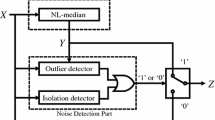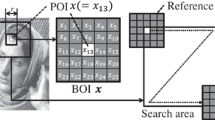Abstract
Image inpainting is the technique of filling-in the missing regions and removing unwanted objects from an image by diffusing the pixel information from the neighbourhood pixels. Image inpainting techniques are in use over a long time for various applications like removal of scratches, restoring damaged/missing portions or removal of objects from the images, etc. In this study, we present a simple, yet unexplored (digital) image inpainting technique using median filter, one of the most popular nonlinear (order statistics) filters. The median is maximum likelihood estimate of location for the Laplacian distribution. Hence, the proposed algorithm diffuses median value of pixels from the exterior area into the inner area to be inpainted. The median filter preserves the edge which is an important property needed to inpaint edges. This technique is stable. Experimental results show remarkable improvements and works for homogeneous as well as heterogeneous background. PSNR (quantitative assessment) is used to compare inpainting results.




















Similar content being viewed by others
References
Bertalmio M, Sapiro G, Caselles V, and Ballester C 2000 Image inpainting. In: Proc. SIGGRAPH. Computer Graphics Processing, 417–424
Bertalmio M, Bertozzi A L and Sapiro G 2001 Navier–Stokes, fluid dynamics and image and video inpainting. In: IEEE CVPR
Bertalmio M. Vese L, Sapiro G and Osher S 2003 Simultaneous strucure and texture image inpainting. In: UCLA CAM report 02–47
Bianjing Bai, Zhenjiang Miao and Zhen Tang 2011 An improved structure propagation based image inpainting. In: Proc. SPIE 8009, 80091D
Chan F and Shen J 2000 Mathematical models for local deterministic inpainting. In: UCLA Computational and Applied Mathematics Reports 00-11, March
Chan F and Shen J 2001 Non-textured inpainting by curvature driven diffusion. J. Vis. Commun. Image. R. 12: 436–449
Chan F, Kang S H, Shen J 2002 Euler’s elastica and curvature-driven diffusion. SIAM J. Appl. Math. 63(2): 564–592
Cheng W-H, Hsieh C-W, Lin S-K, Wang C-W, Wu J-L 2005 Robust Algorithm for Exemplar-Based Image Inpainting. In: The International Conference on Computer Graphics, Imaging and Vision (CGIV 2005), 64–69, Beijing, China
Criminisi A, Perez P and Toyama K 2004 Object removal by exempler-based inpainting. IEEE Trans. Image Proc. 13(9): 1200–1212
Emile-Male G 1976 The restorer’s handbook of easel painting. New York: Van Nostrand Reinhold
Efros A and Leung T 1999 Texture synthesis by non-parametric sampling. In: Proc. IEEE International Conference Computer Vision, 1033–1038, Corfu, Greece, September
Grossauer H 2003 Digital Inpainting using the complex Ginzburg–Landau equation. In: Scale Space Method in Computer Vision, Lecturer Notes 2695
Grssauer H 2004 A Combined PDE and Texture Synthesis Approach to Inpainting, volume 3022, 214–224
Grossauer H and Scherzer O 2003 Using complex Ginzburg-Landau equation for image inpainting. In: Scale Space Method in Computer Vision, Lecturer Notes 2695
Hadhoud M M, Moustafa Kamel and Shenoda 2005 Digital image inpainting using modified convolution based method. Int. J. Sig. Process. Image Process. Pattern Recog. 1(1): 1–10
Hirani A and Totsuka T 1996 Combining frequency and spatial domain information for fast interactive image noise removal. In: Comput. Graph., SIGGRAPH, volume 96, 269–276
Ioannis Pitas and Anastasios N V 1992 Order statistics in digital image processing. In: Proc. IEEE, 1893–1921, December
Masnou S and Morel J M 1998 Level-lines based disocclusion. In: 5th IEEE International Conference on Image Processing, Chicago, IL, October 4–7
Noori H, Saryazdi S and Nezamabadi-pour H 2010 A convolution based image inpainting. In: 1st International Conference on Communication and Engineering, University of Sistan & Baluchestan, December
Noori H, Saryazdi S and Nezamabadi-pour H 2011 A bilateral image inpainting. IJST Trans. Electr. Eng. 35(E2): 95–108, printed in the Islamic Republic of Iran, Shiraz University
Olivera M, Bowen B, Mckenna R and Chang Yu-Sung 2001 Fast Digital Image Inpainting. In: VIIP 2001, 261–266 [PUB]
Perona P and Malik J 1990 Scale-space edge detection using anisotropic diffusion. IEEE Transaction on Pattern Analysis 12(7): 629–639
Roth Stefan and Black Michael J 2005 Field of expert: A framework for learning image priors. In: IEEE Conference on Computer Vision and Pattern Recognition (CVPR), volume 2, 860–867, June
Tai X C, Osher S, Holm R 2006 Image inpainting using TV-Stokes equation. In: Image Processing Based on Partial Differential Equations, 473–482. Springer, Heidelberg
Telea A 2004 An image inpainting technique based on the fast marching method. J. Graphics Tools 9(1): 25–36. ACM Press
Walden S 1985 The ravished image. New York: St Martin’s Press
Zhang Y, Pu Y-F, Hu J-R and Zhou J-L 2011 Fast X-ray CT metal artifacts reduction based on noniterative sinogram inpainting. In: Nucl. Sci. Symp. Med. Imaging Conf. (NSS/MIC)
Zhang Y, Pu Y-F, Hu J-R and Zhou J-L 2012 A class of fractional order variational image inpainting models. Appl. Math. Inf. Sc. Int. J. 2: 299–306
Author information
Authors and Affiliations
Corresponding author
Appendix A
Appendix A
Median is the maximum likelihood estimator of location for Laplacian distribution (Ioannis & Anastasios 1992).
This distribution is symmetric about μ and decreases exponentially to right and left, with λ the dispersion parameter. It will be seen that the sample median \(\overline x \) is the maximum likelihood estimator of μ.
Proof: The dispersion parameter is given by
The likelihood function of μ is given by
Maximizing ϕ with respect to μ is equivalent to minimizing \(\sum\limits_{i=1}^n {\left| {x_i -\mu } \right|} \). This sum is minimum for a set of {x i } when μ is the median of the set. Furthermore, setting \({\partial \phi } \mathord{\left/ {\vphantom {{\partial \phi } {\partial \lambda =0}}} \right. \kern-\nulldelimiterspace} {\partial \lambda =0}\) readily yields the estimator for λ.
Rights and permissions
About this article
Cite this article
BIRADAR, R.L., KOHIR, V.V. A novel image inpainting technique based on median diffusion. Sadhana 38, 621–644 (2013). https://doi.org/10.1007/s12046-013-0152-2
Received:
Revised:
Accepted:
Published:
Issue Date:
DOI: https://doi.org/10.1007/s12046-013-0152-2




